► 1984 Porsche 911 Carrera 3.2 4×4
► 225bhp, 1235kg and a 270-litre fuel capacity
► Won the Paris Dakar on its first outing
To many, the 2023 launch of the 911 Dakar will feel like Porsche braving a whole new world, far away from the race tracks of Le Mans and Spa where many of its most famous motorsport victories have occurred. However, the 911 Dakar is far from its first off-road rodeo and indeed the model itself got its name from an early Porsche 911 off-roader.
Introducing the Porsche 911 Carrera 3.2 4×4 Paris Dakar. Based on the 953, this car took on and conquered the 1984 Paris Dakar rally – a gruelling near 7,000-mile endurance race through the Sahara desert often dubbed the toughest in the world. Among the 400 vehicles sitting on the start line at the Place de la Concorde in Paris on New Year’s Day 1984, three 4×4 911s (one piloted by the previous year’s winner, Jacky Ickx) stuck out – their low, sportscar lines among a sea of trucks and off-roaders.
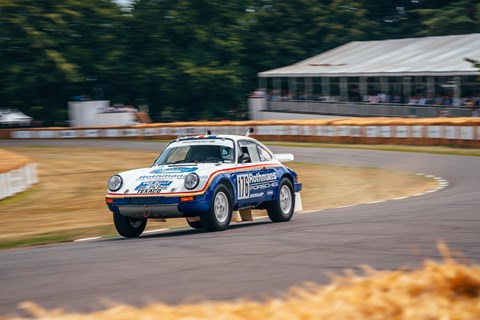 The 953 takes to the Goodwood FoS hill
The 953 takes to the Goodwood FoS hill
Across the next 20 days, each car would face conditions that no 911 had likely faced before. Ickx and co-driver Claude Brasseur hit trouble with a cable fire but still battled back to finish sixth by the end of the race, while the third car – driven by the car’s project manager Roland Kussmaul and Erich Lerner – crossed the line in a respectable 26th. As for the René Metge and Dominique Lemoyne entry being driven here at Goodwood almost 40 years later? It took overall victory and marked the first time a sports car had ever won the event.
Sliding over the high sill and climbing into the battle-worn cabin in the altogether different surrounds of the Goodwood Estate, two immediate thoughts cross my mind. One, that the history imbued within the car is palpable – from the retro nav unit and timing gear to the patina effect metal bar in front of the co-driver – and two, it still feels very much like a 953. It’s not a crazy prototype racer that bears very little resemblance to its road-going equivalent – see my piece on the 911 GT1 for an example of that – rather a highly modified road car prepped for a brutal battle with the elements.
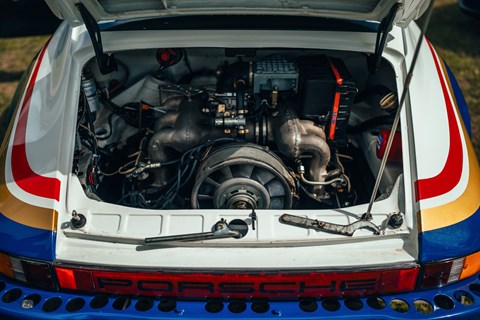 3.2-litre flat-six ran lower compression due to poor fuel quality
3.2-litre flat-six ran lower compression due to poor fuel quality
The steering wheel, for example, looks like it’s been taken straight from the base model As do the trademark five dials dead ahead and the gearlever low to my right. Porsche’s always have a very distinctive smell, but this is entirely different. It’s one that reflects the lives of 1,000 cars, all condensed through those 7,000 miles. The odometer reads 11,596km (7,205 miles) – meaning the car has completed less than 400 miles since 1984. And now I’m about to add a few more.
Prime the two fuel pumps (yes, two, there’s a 120-litre fuel tank at the front and 170-litre tank at the back), turn the key and bring that throaty 3.2-lite flat-six back to life. The sound reverberates around the Goodwood paddock like constant gunfire. It has to be one of the loudest things here. But then, the engine is no doubt glad to be drinking some of the good stuff. Back in original Paris-Dakar trim, it was running reduced compression to cope with low-quality local fuel and ‘only’ produced 225bhp – not a huge issue when the whole car weighs just 1,235kg.
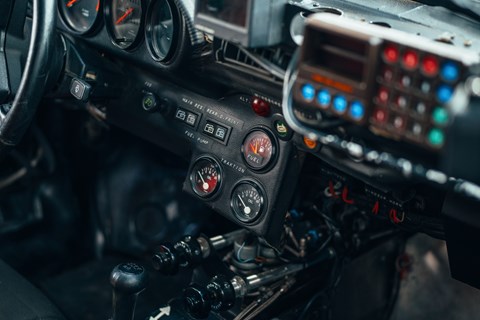 Recognisable road-car cabin – with a few extras…
Recognisable road-car cabin – with a few extras…
Other changes included 27cm of wheel travel, double wishbone suspension with double shock absorbers at the front and a reinforced rear axle with additional coil springs. A welded-in steel roll cage also features, while the doors, roof, front bumper and side and rear windows are made of plastic.
Naturally, the tyres are rally raid spec as well, and together with the 31:69 front/rear power distribution make for a floaty run through the first corner of the Goodwood hillclimb. I’d gotten off the line well despite the razor-sharp clutch, yet tipping it into the right hander revealed little feel through the steering and even less grip from the rear tyres. And yet, thankfully, it wasn’t snappy or unpredictable, the oversteer coming in and leaving with little sense of urgency.
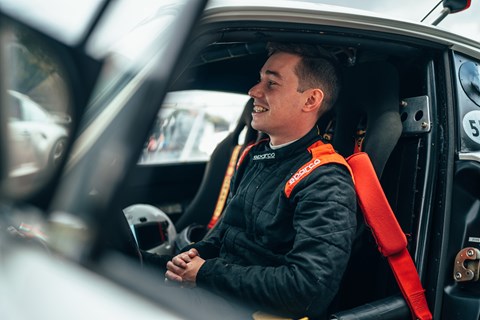 James at the wheel of the 953
James at the wheel of the 953
In fact, it almost feels like the perfect car for the Goodwood hillclimb. Controllably sideways at very low speeds, incredibly loud, short gear ratios and the ability, no wait, encouragement, to take to the grass whenever the mood takes you. Doing so only further endears it to the thousands of spectators lining the hill route, already enthralled by its buggy-like silhouette, uber-cool livery and bone-shaking sound as I rattle through the gears.
Sending it through Molecomb and the Flint Wall and finally to the long finish straight, piloting its roll-happy bodyshell and raised-up ground clearance feels like second nature. I can only wonder what the residents of countries like Ivory Coast, Sierra Leone and Mauritania thought as this Porsche sports car forged a path across the desert plains, flat-six roaring, Metge and Lemoyne on a knife edge between speed and endurance. Modern rally monsters may now surpass it on both counts, but for the time I can think of few better cars to cover 7,000 miles of punishing desert terrain in – just so long as I remember to pack my ear plugs.
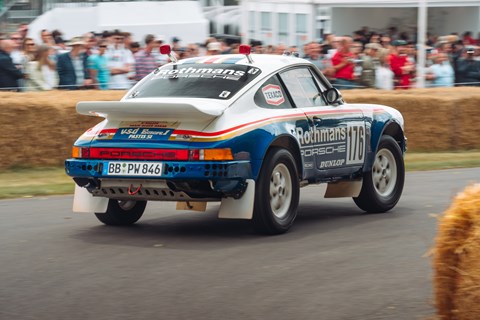 Serious ground clearance on the 953
Serious ground clearance on the 953